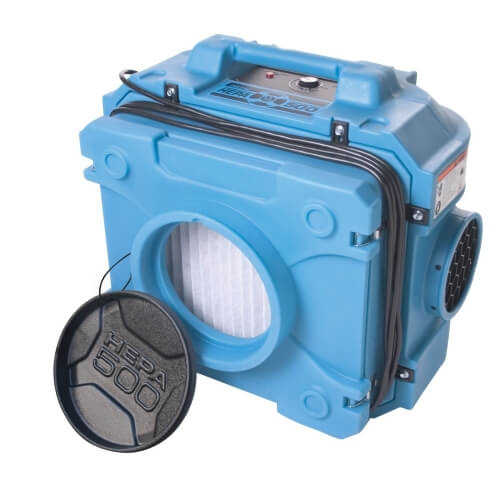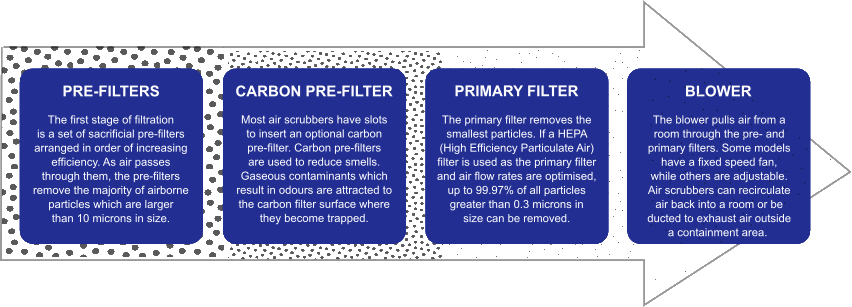BACS Top Tips When Using an Air Scrubber
A portable air scrubber is an air circulator which draws the atmosphere of a room through a series of filters to reduce levels of particles and gases before releasing purified air out of the other side. Using an air scrubber prevents potentially harmful contaminants from entering equipment or human airways. During 36 years of technical cleaning, BACS has learned a few things about how to get the best performance from an air scrubber.

When to Use an Air Scrubber
- To reduce dust levels generated by construction, maintenance or cleaning activities in data centres or any other critical environment.
- To reduce volatile organic compounds (VOCs) and other gaseous contaminants.
- To provide additional air filtration when regular air conditioning units are not operating.
- To dry out an area quickly after a leak or flood.
- To stop spores from spreading during mould remediation.
- To remove burnt odour and reduce airborne soot levels when cleaning up after a fire.
Cleaning vs Air Scrubbing
Most particles in the visible and invisible size range eventually settle on a surface. Smaller particles take longer to do so than larger particles. In completely still conditions, a human hair that is 100 microns in diameter might take 5 seconds to land. A 10 micron mould spore, on the other hand, could remain airborne for 5 minutes or longer. In more turbulent conditions, larger particles stay afloat for longer periods of time and can spread farther before coming to rest.
While settled particles can be removed by physically wiping them from a surface, the smallest particles are light enough to remain suspended in air indefinitely. Using an air scrubber is one way to remove these floating particles. However, air scrubbers are only effective for reducing airborne particle levels. The units must be used in conjunction with thorough surface cleaning to achieve ISO Class 14644-1:2015 particle level standards in a critical or controlled environment.
Anatomy of an Air Scrubber
A typical air scrubber consists of four parts. Understanding the purpose and function of each part will allow you to optimise an air scrubber’s operation.

| ⇨ |
| ⇩ |
| PRE-FILTERS |
| The first stage of filtration is a set of sacrificial pre-filters arranged in order of increasing efficiency. As air passes through them, the pre-filters remove the majority of airborne particles which are larger than 10 microns in size.
|
| ⇨ |
| ⇩ |
| CARBON PRE-FILTER |
| Most air scrubbers have slots to insert an optional carbon pre-filter. Carbon pre-filters are used to reduce smells. Gaseous contaminants which result in odours are attracted to the carbon filter surface where they become trapped. |
| ⇨ |
| ⇩ |
| PRIMARY FILTER |
| The primary filter removes the smallest particles. If a HEPA (High Efficiency Particulate Air) filter is used as the primary filter and air flow rates are optimised, up to 99.97% of all particles greater than 0.3 microns in size can be removed.
|
| ⇨ |
| ⇩ |
| BLOWER |
| The primary filter removes the smallest particles. If a HEPA (High Efficiency Particulate Air) filter is used as the primary filter and air flow rates are optimised, up to 99.97% of all particles greater than 0.3 microns in size can be removed.
|
Here are ten easy ways to get the best results when using an air scrubber.
1. Don’t overload pre-filters.
Change relatively inexpensive pre-filters frequently, before they become clogged. Pre-filters which are not overloaded ensure air flow rates remain high, decrease the strain on the blower motor, and extend the life of more expensive carbon and primary filters. Using higher quality filters minimises air resistance and lowers the pressure drop after the filter for maximum filtration efficiency.
2. Dispose of used filters properly.
Particles which have been trapped by a filter can be inhaled if they become dislodged when changing filters. Wear a facemask and gloves, as needed. Remove the air scrubber from the room when replacing filters to avoid releasing loose particles back into the environment. Place used filters in plastic bags, seal the top of the bag with tape, and dispose of filter and bag properly, following local regulations.
3. Use activated carbon pre-filters to eliminate odours.
Activated carbon pre-filters are the best choice to reduce unpleasant smells. Because they are more porous than regular carbon filters, they have a greater surface area to absorb odour. A 40 g portion of activated carbon has the same surface area as the Melbourne Cricket Ground. The porous material allows air to pass through, while the surface retains vapour-phase contaminants. Change the activated carbon pre-filter when it becomes saturated and the smell is still present in the exhausted air.
4. Set air flow rate appropriately on adjustable units.
Slower air flow rates result in particles having a longer time in contact with filter media to attach, resulting in a higher capture rate. However, slower air flow rates produce fewer air changes per hour in the room. Increasing the air flow rate increases the air exchange, but not necessarily the filtration efficiency. If air flow is too fast, filters can be overwhelmed. Check the manufacturer’s operating instructions for recommended blower speed settings on variable units.
5. Purify 24/7.
Air scrubbers can run unattended overnight or even during a weekend to further purify the air afterhours. Because operating at lower air flow rates increases filtration efficiency, running air scrubbers over a longer period of time compensates for fewer air changes per hour in the room.
6. HEPA media & HEPA filters are not the same thing.
Although a filter media can be HEPA-rated under lab test conditions, that does not mean that a primary filter made from HEPA media removes 99.97% of all particles greater than 0.3 micron when used in an air scrubber under real-world conditions. Look for HEPA-rated filters, not just those made from HEPA-rated filter media. Set the blower to an air flow rate which does not compromise the ability of the filter to achieve HEPA filtration levels, if they are required. A blower may be rated to operate at air flow rates up to 3400 m3/hr, but air flow rates as low as 250 m3/hr could be needed to achieve HEPA filtration levels.
7. Avoid cross-contamination.
At a minimum, change pre-filters between each job to reduce the chance of cross-contamination. Depending on the type of environment in which the air scrubber was previously used (mould remediation, for example), consider also changing the carbon pre-filter (if using) and the primary filter. Thoroughly wipe down moisture-tolerant surfaces of the unit with neutral detergent or isopropyl alcohol to avoid introducing unknown contaminants into your environment.
8. Form a containment zone.
Position several air scrubbers around an area where contaminants are being generated to capture impurities at the source before they can migrate into other areas. Some units are even designed to be stackable. For example, have one or more air scrubbers operating around mould remediation or dust-producing maintenance activities such as drilling into a wall.
9. Avoid pockets of stagnant air.
Rather than using a single high-powered unit situated in a central location, consider placing several lower air flow air scrubbers around the room in key positions. This arrangement avoids having areas where stagnant air is not being properly circulated by a single unit and gives an overall better result.
10. Create a sealed containment.
Air scrubbers can also be used to supply purified air. When dust-generating major works are occurring, a temporary sealed containment area can be built from plastic sheeting supported by a framework around any equipment which cannot be moved and must continue to operate. The air scrubber is positioned so that room air is drawn through the filters and purified air is released inside the containment. Air flow rates are adjusted to maintain positive pressure in the containment which helps to further keep contamination from entering.
Need an Air Scrubber?
Contact BACS to rent air scrubbers by the day, week, month, or longer.
Compliment Air Scrubber with these Products